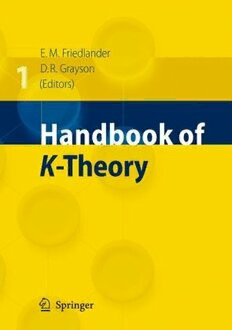
Handbook of K-theory PDF
Preview Handbook of K-theory
Handbook of K-Theory Volume 1 Eric M. Friedlander Daniel R. Grayson Editors Handbook of K-Theory Volume 1 123 Editors Eric M. Friedlander Department of Mathematics Northwestern University Evanston, Illinois 60208 USA e-mail: [email protected] Daniel R. Grayson Department of Mathematics University of Illinois at Urbana-Champaign Urbana, Illinois 61801 USA e-mail: [email protected] Library of Congress Control Number: 2005925753 ISBN-10 3-540-23019-X Springer Berlin Heidelberg New York ISBN-13 978-3-540-23019-9 Springer Berlin Heidelberg New York This work is subject to copyright. All rights are reserved, whether the whole or part of the material is concerned, specifically the rights of translation, reprinting, reuse of illustrations, recitation, broadcasting, reproduction on microfilm or in any other way, and storage in data banks. Duplication of this publication or parts thereof is permitted only under the provisions of the German Copyright Law of September 9, 1965, in its current version, and permission for use must always be obtained from Springer. Violations are liable for prosecution under the German Copyright Law. Springer is a part of Springer Science+Business Media springeronline.com © Springer-Verlag Berlin Heidelberg 2005 Printed in Germany The use of general descriptive names, registered names, trademarks, etc. in this publication does not imply, even in the absence of a specific statement, that such names are exempt from the relevant protective laws and regulations and therefore free for general use. Typesetting and Production: LE-TEX Jelonek, Schmidt & Vöckler GbR, Leipzig Cover design: deblik, Berlin Printed on acid-free paper 41/3142/YL 5 4 3 2 1 0 Preface This volume is a collection of chapters reflecting the status of much of the cur- rentresearchinK-theory.Aseditors,ourgoalhasbeentoprovideanentryand an overview to K-theory in many of its guises. Thus, each chapter provides its author an opportunity to summarize, reflect upon, and simplify a given topic which has typically been presented only in research articles. We have grouped these chapters into five parts, and within each part the chapters are arranged alphabetically. Informally, K-theory is a tool for probing the structure of a mathematical object such as a ring or a topological space in terms of suitably parameterized vectorspaces. Thus,insomesense,K-theorycanbeviewedasaformofhigher orderlinearalgebrathathasincorporatedsophisticatedtechniquesfromalgebraic geometry and algebraic topology in its formulation. As can be seen from the variousbranchesofmathematicsdiscussedinthesucceedingchapters,K-theory givesintrinsicinvariantswhichareusefulinthestudyofalgebraicandgeometric questions. In low degrees, there are explicit algebraic definitions of K-groups, beginningwiththeGrothendieckgroupofvectorbundlesasK ,continuingwith 0 H.Bass’s definition of K motivated inpartby questions ingeometric topology, 1 andincludingJ.Milnor’sdefinitionofK arisingfromconsiderationsinalgebraic 2 number theory<. On the other hand, even when working in a purely algebraic context, one requires techniques from homotopy theory toconstruct the higher K-groups K and to achieve computations. The resulting interplay of algebra, i functional analysis, geometry, and topology in K-theory provides a fascinating glimpseoftheunityofmathematics. K-theory has its origins in A. Grothendieck’s formulation and proof of his celebrated Riemann-Roch Theorem [5] in the mid-1950’s. While K-theory now playsasignificantroleinmanydiversebranchesofmathematics,Grothendieck’s original focus on the interplay of algebraic vector bundles and algebraic cycles onalgebraicvarietiesismuchreflectedincurrentresearch,ascanbeseeninthe chaptersofPartII.TheapplicabilityoftheGrothendieckconstructiontoalgebraic topologywasquicklyperceivedbyM.AtiyahandF.Hirzeburch[1],whodeveloped VI Preface topologicalK-theoryintothefirstandmostimportantexampleofa“generalized cohomologytheory”.Alsointhe1960’s,workofH.Bassandothersresultedinthe formulationandsystematicinvestigationofconstructionsingeometrictopology (e.g.,thatoftheWhiteheadgroupandtheSwanfinitenessobstruction)involving theK-theoryofnon-commutativeringssuchasthegroupringofthefundamental groupofamanifold.OtherssoonsawtherelevanceofK-theoretictechniquesto numbertheory,forexampleinthesolutionbyH.Bass,J.Milnor,andJ.-P.Serre[2] of thecongruence subgroup problemand theconjectures of S. Lichtenbaum[6] concerningthevaluesofzetafunctions. Intheearly1970’s,D.Quillen[8]providedthenowaccepteddefinitionofhigher algebraicK-theoryandestablishedremarkablepropertiesof“Quillen’sK-groups”, therebyadvancingtheformalismofthealgebraicsideofK-theoryandenabling variouscomputations.AnimportantapplicationofQuillen’stheoryistheidentifi- cationbyA.MerkurjevandA.Suslin[7]ofK ⊗Z|nofafieldwithn-torsioninthe 2 Brauergroup.OtherssoonrecognizedthatmanyofQuillen’stechniquescouldbe appliedtoringswithadditionalstructure,leadingtothestudyofoperatoralgebras andtoL-theoryingeometrictopology.ConjecturesbyS.Bloch[4]andA.Beilin- son[3]concerningalgebraicK-theoryandarithmeticalalgebraicgeometrywere also formulated during the 1970’s; these conjectures prepared the way for many currentdevelopments. We now briefly mention the subject matter of the individual chapters, which typicallypresentmathematicsdevelopedinthepasttwentyyears. PartIconsistsoffivechapters,beginningwithGunnarCarlsson’sexpositionof theformalismofinfiniteloopspacesandtheirroleinK-theory.Thisisfollowed bythechapterbyDanielGraysonwhichdiscussesthemanyefforts,recentlyfully successful,toconstructaspectralsequenceconvergingtoK-theoryanalogousto theveryusefulAtiyah-HirzebruchspectralsequencefortopologicalK-theory.Max Karoubi’schapterisdedicatedtotheexpositionofBottperiodicityinvariousforms of K-theory: topological K-theory of spaces and Banach algebras, algebraic and HermitianK-theoryofdiscreterings.ThechaptersbyLarsHesselholtandCharles Weibel present two of the most successful computations of algebraic K-groups, namelythatoftruncatedpolynomialalgebrasoverregularnoetherianringsover afieldandofringsofintegersinlocalandglobalfields.Thesecomputationsare farfromelementaryandhaverequiredthedevelopmentofmanynewtechniques, someofwhichareexplainedinthese(andother)chapters. Some of the important recent developments in arithmetic and algebraic ge- ometryandtheirrelationshiptoK-theoryareexploredinPartII.Inadditionto adiscussionofmuchrecentprogress,thereaderwillfindinthesechaptersconsid- erablediscussionofconjecturesandtheirconsequences.ThechapterbyThomas GeissergivesanexpositionofBloch’shigherChowgroups,thendiscussesalgebraic K-theory,étaleK-theory,andtopologicalcyclichomology.HenriGilletexplains howalgebraicK-theoryprovidesausefultoolinthestudyofintersectiontheory ofcyclesonalgebraicvarieties.Variousconstructionsofregulatormapsarepre- sentedinthechapterbyAlexanderGoncharovinordertoinvestigatespecialvalues ofL-functionsofalgebraicvarieties.BrunoKahndiscussestheinterplayofalge- Preface VII braicK-theory,arithmeticalgebraicgeometry,motivesandmotiviccohomology, describingfundamentalconjecturesaswellassomeprogressontheseconjectures. MarcLevine’schapterconsistsofanoverviewofmixedmotives,includingvarious constructionsandtheirconjecturalroleinprovidingafundamentalunderstanding ofmanygeometricquestions. Part III is a collection of three articles dedicated to constructions relating algebraic K-theory (including the K-theory of quadratic spaces) to “geometric topology” (i.e., the study of manifolds). In the first chapter, Paul Balmer gives amodernandgeneralsurveyofWittgroupsconstructedinafashionanalogous totheconstructionofalgebraicK-groups.JonathanRosenberg’schaptersurveys agreatrangeoftopicsingeometric topology,reviewingrecentaswellasclassi- calapplicationsofK-theorytogeometry.BruceWilliam’chapteremphasizesthe role of the K-theory of quadratic forms in the study of moduli spaces of mani- folds. In Part IV are grouped three chapters whose focus is on the (topological) ∗ K-theoryofC -algebrasandothertopologicalalgebraswhichariseinthestudyof differentialgeometry.JoachimCuntzpresentsinhischapteraninvestigationofthe K-theory, K-homology and bivariant K-theory of topological algebras and their relationshipwithcyclichomologytheoriesviaCherncharactertransformations. In their long survey, Wolfgang Lueck and Holger Reich discuss the significant progress made towards the complete solution of important conjectures which ∗ would identify the K-theory or L-theory of group rings and C -algebras with appropriateequivarianthomologygroups.InthechapterbyJonathanRosenberg, therelationshipbetweenoperatoralgebrasandK-theoryismotivated,investigated, andexplainedthroughapplications. ThefifthandfinalpartpresentsotherformsandapproachestoK-theorynot foundinearlierchapters.EricFriedlanderandMarkWalkersurveyrecentworkon semi-topological K-theory that interpolates between algebraic K-theory of vari- etiesandtopologicalK-theoryofassociatedanalyticspaces.AlexanderMerkurjev develops the K-theory of G-vector bundles over an algebraic variety equipped withanactionofagroupGandpresentssomeapplicationsofthistheory.Stephen Mitchell’s chapter demonstrates how algebraic K-theory provides an important linkbetweentechniquesinalgebraicnumbertheoryandsophisticatedconstruc- tionsinhomotopytheory.ThefinalchapterbyAmnonNeemanprovidesahistor- icaloverview and throughinvestigation ofthechallenge of recoveringK-theory fromthestructureofatriangulatedcategory. Finally, two Bourbaki articles (by Eric Friedlander and Bruno Kahn) are re- printed in the appendix. The first summarizes some of the important work of A.SuslinandV.Voevodskyonmotiviccohomology,whereasthesecondoutlines thecelebratedtheoremofVoevodskyestablishingthevalidityofaconjectureby J.MilnorrelatingK(−)⊗Z|2,Galoiscohomology,andquadraticforms. Somereaderswillbedisappointedtofindnochapterdedicatedspecificallyto low-degree (i.e., classical) algebraic K-groups and insufficient discussion of the role of algebraic K-theory to algebraic number. We fullyacknowledge themany VIII Preface limitationsofthishandbook,buthopethatreaderswillappreciatetheexpository effortandskillsoftheauthors. April,2005 EricM.Friedlander DanielR.Grayson References 1.M.F. Atiyah and F. Hirzebruch. Vector bundles and homogeneous spaces. In Proc.Sympos.PureMath.,Vol.III, pages 7–38. American Mathematical Soci- ety,Providence,R.I.,1961. 2.H.Bass,J.Milnor,andJ.-P.Serre.Solutionofthecongruencesubgroupproblem forSL (n ≥ 3)andSp (n ≥ 2).Inst.HautesÉtudesSci.Publ.Math.,33:59– n 2n 137,1967. 3.AlexanderBeilinson.HigherregulatorsandvaluesofL-functions(inRussian). InCurrentproblemsinmathematics,Vol.24,ItogiNaukiiTekhniki,pages181– 238.Akad.NaukSSSRVsesoyuz.Inst.Nauchn.iTekhn.Inform.,Moscow,1984. 4.Spencer Bloch. Algebraic cycles and values of L-functions. J.ReineAngew. Math.,350:94–108,1984. 5.ArmandBorelandJean-PierreSerre.LethéorèmedeRiemann-Roch.Bull.Soc. Math.France,86:97–136,1958. 6.Stephen Lichtenbaum. Values of zeta-functions, étale cohomology, and algebraic K-theory. In AlgebraicK-theory,II:“Classical”algebraicK-theory andconnectionswitharithmetic(Proc.Conf.,BattelleMemorialInst.,Seattle, Wash.,1972),pages489–501.LectureNotesinMath.,Vol.342.Springer,Berlin, 1973. 7.A.S.Merkur’evandA.A.Suslin.K-cohomologyofSeveri-Brauervarietiesand thenormresiduehomomorphism.Izv.Akad.NaukSSSRSer.Mat.,46(5):1011– 1046,1135–1136,1982. 8.DanielQuillen.Higheralgebraic K-theory.I.InAlgebraicK-theory,I:Higher K-theories(Proc. Conf., Battelle Memorial Inst., Seattle, Wash., 1972), pages 85–147.LectureNotesinMath.,Vol.341.Springer,Berlin,1973. Table of Contents – Volume 1 I.FoundationsandComputations I.1DeloopingsinAlgebraicK-Theory GunnarCarlsson..........................................................3 I.2TheMotivicSpectralSequence DanielR.Grayson........................................................39 I.3K-TheoryofTruncatedPolynomialAlgebras LarsHesselholt...........................................................71 I.4BottPeriodicityinTopological,AlgebraicandHermitianK-Theory MaxKaroubi ........................................................... 111 I.5AlgebraicK-TheoryofRingsofIntegersinLocalandGlobalFields CharlesWeibel..........................................................139 II.K-TheoryandAlgebraicGeometry II.1MotivicCohomology,K-TheoryandTopologicalCyclicHomology ThomasGeisser.........................................................193 II.2K-TheoryandIntersectionTheory HenriGillet.............................................................235 II.3Regulators AlexanderB.Goncharov.................................................295 II.4AlgebraicK-Theory,AlgebraicCyclesandArithmeticGeometry BrunoKahn............................................................351 II.5MixedMotives MarcLevine............................................................429 Index..................................................................523
